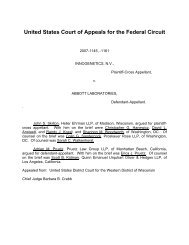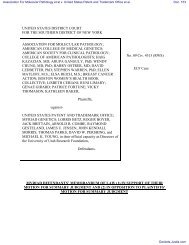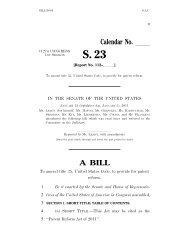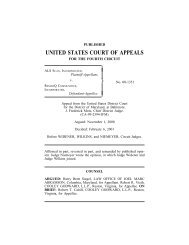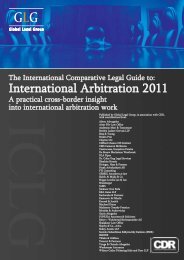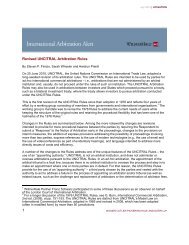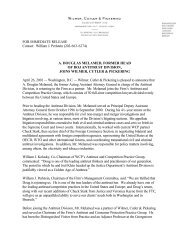2008 IPO Report - Initial Public Offerings
2008 IPO Report - Initial Public Offerings
2008 IPO Report - Initial Public Offerings
You also want an ePaper? Increase the reach of your titles
YUMPU automatically turns print PDFs into web optimized ePapers that Google loves.
14Dual Track <strong>IPO</strong>s – Pursuing Parallel Paths to LiquiditySometimes, a company (or itsinvestors) is torn between an <strong>IPO</strong>and a sale. The company may be qualifiedand willing to take on an <strong>IPO</strong>, yet enticedby the prospect of selling and unsure howto compare the relative ease and certaintyof being acquired with the equity upsideof an <strong>IPO</strong>. The choice can pose a quandaryif <strong>IPO</strong> market conditions are choppy,creating execution risk for any <strong>IPO</strong> plan.In these cases the optimum choice maybe a “dual track,” in which the companysimultaneously pursues an <strong>IPO</strong> whileentertaining—or even courting—suitors.Anecdotal evidence suggests dual trackefforts are increasing in frequency, as theperceived burdens of public company lifehave increased and <strong>IPO</strong>s have becomemore difficult to complete. A dual trackstrategy presents various challenges:■Importance of Confidentiality: Evenmore so than usual, the M&A processmust be kept under wraps, to minimizethe risk of premature disclosureand to avoid disruption to the effortand focus demanded of the <strong>IPO</strong> process.■Disclosure Issues: Absent a leak,the sale process usually need not bepublicly disclosed prior to an acquisitionannouncement. A dual track strategycan, however, result in thorny disclosureissues if the company opts for an <strong>IPO</strong>rather than a sale. For example, ifan acquisition deal is reached and thenfalls apart, the company must considerwhether the reasons for the busteddeal must be disclosed in the <strong>IPO</strong>prospectus—this could prompt negativedisclosures and delay an <strong>IPO</strong> whilethe prospectus is supplemented.■Legal Advisor: The company willalmost certainly utilize its <strong>IPO</strong> lawfirm for the M&A track as well—to usedifferent counsel for the two tracks wouldsquander the hard-earned institutionalknowledge from the <strong>IPO</strong> process andcreate logistical and other challenges—but should make sure appropriate M&Aexpertise is available on the companycounsel team for the potential sale.■Selection of Financial Advisors: Thecompany will ordinarily want financialadvisors to handle the sale side of the dualtrack. The <strong>IPO</strong> lead underwriters willknow the company best and be obviouschoices for the M&A engagement. Ifone (but not all) of the lead underwritersis selected as the M&A advisor and theconcurrent sale process is not disclosedto the other lead underwriters,complications can result. Also, theeconomic outcomes may be differentfor financial advisors on a sale transactionthan for underwriters in an <strong>IPO</strong>, whichmay give the selected party or partiesan incentive to steer the process one wayor the other.■Potential for Conflicted Motivations:The company’s management and keyemployees may also have financialincentives to prefer one alternative overthe other. A company sale will often resultin the replacement of top management,particularly the CEO and CFO, but mayalso trigger equity acceleration andchange-in-control and severancepayments. On the other hand, an <strong>IPO</strong>will offer management continuedemployment and the potential for marketappreciation, but without the immediaterealization of change-in-control benefits.The company’s board of directors needsto be conscious of the hazards posedby any skewed incentives, and in somecases may need to make adjustments toachieve the best outcome for stockholders.■Board Duties: The board’s fiduciaryduties to stockholders obviously applywhen considering the choice of an <strong>IPO</strong>or company sale and when evaluatingacquisition offers. The board is notcompelled to accept an acquisitionoffer that is within the estimated <strong>IPO</strong>price range, but the board will want tofollow an appropriate process in a dualtrack, as it would in any sale process.■Valuation Impact: A dual track can createtricky valuation issues for the company.If the company pursues an <strong>IPO</strong> afterreceiving one or more acquisition offers,it must consider the impact of these offerson its subsequent determinations of fairmarket value for option grants made priorto the <strong>IPO</strong>. Similarly, the company willneed to evaluate whether the amountof any acquisition offers should—ormust—be disclosed in response to cheapstock comments from the SEC.■Timing Considerations: Althougha company can pursue both sides ofa dual track strategy for a long time,it eventually must select one alternative.In theory, the day of reckoning canbe delayed until after the <strong>IPO</strong> roadshow and moments before inkingthe underwriting agreement. In reality,the choice is usually made before going onthe road, because a road show is expensiveand time-consuming and underwritersare leery of irritating fund managers withmeaningless presentations. If an attractiveacquisition offer does not seem imminent,the sale process is ordinarily shut downwhen the road show begins.■Sale Terms: If an acceptable acquisitionoffer emerges from a dual track process,the focus will shift to a traditional M&Anegotiation, but with two wrinkles. One,there will be a heightened urgency to signa definitive agreement quickly, so thatthe company does not lose its <strong>IPO</strong>window in the event the sale cannot beconcluded. Two, the company may seekto style the definitive agreement as if thetransaction were a “public-public” merger,with no representations, indemnitiesor escrows following the closing.■Unwinding the <strong>IPO</strong>: Assuming anacquisition agreement is signed after theForm S-1 has been filed, the company’s<strong>IPO</strong> filings will need to be withdrawnprior to closing the sale. Since a dealcan come undone for many reasons,it is usually advisable to keep the FormS-1 and exchange listing applicationon file until shortly before the closing.■Extra Effort and Expense: A dual trackcombines the rigors of an <strong>IPO</strong> withthe effort of a company sale process,and usually in a compressed timeframe. A handful of key participantswill bear the brunt of the extraburden, and the company should seizeefficiency opportunities—such as avirtual data room where due diligencematerials can be made available tounderwriters’ counsel and multiplebidders simultaneously—when available.Although both an <strong>IPO</strong> underwritingdiscount and an M&A success fee willnot be paid, total transaction expensesin a dual track strategy usually exceedthe expenses of either path alone.





